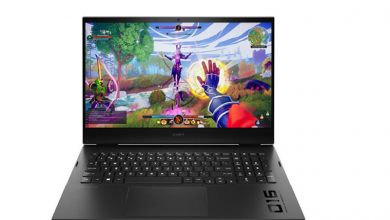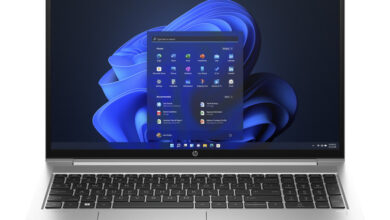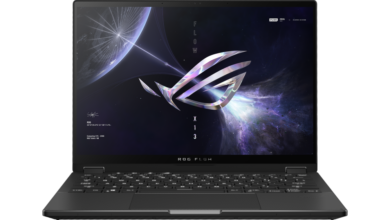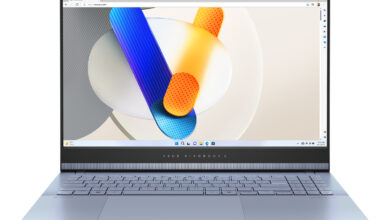MSI is a well-known brand in the realm of traditional computer brands. The company produces a wide range of notebooks, from gaming-focused to business-oriented and even graphic design-centric models. The company has different lineups for gaming notebooks, including Titan, Stealth, Crosshair, and many others. The notebook, our primary focus in this article, belongs to MSI’s Crosshair series.
The laptop we are going to review today is named MSI Crosshair 16 HX D14V and is the latest addition to the Crosshair/Pulse series. The laptop is powered by Intel’s latest 14th-generation Core i7-14700HX, the most powerful chipset yet in the Core i7 lineup. In addition to this CPU, the notebook also comes with RTX 4060 Mobile GPU. The notebook is also available in a higher GPU variant equipped with RTX 4070 GPU but at a higher price.
The company has provided a 16-inch IPS LCD Display with high resolution and 240Hz refresh rate for a crystal clear and smooth display experience. It is worth mentioning that the 16 in the notebook’s name represents the display size. When it comes to memory and storage, the laptop supports all the latest protocols, including the DDR5 RAM and PCIe 5.0 SSD support. Based on these specifications, we expect a robust performance from the Crosshair 16 HX. So, let’s check.
MSI Crosshair 16 HX D14V: Specifications
| Screen | 16” QHD+ (2560×1600), 240Hz, 16:10 Aspect Ratio, IPS-Level, 100% DCI-P3 |
| Processor | Intel Core i7-14700HX CPU (14th Gen), Total 20 Cores including 8 P-Cores and 12 E-Cores |
| Wireless Connection | 802.11 ax Wi-Fi 6E + Bluetooth v5.3 |
| Graphics card | NVIDIA GeForce RTX 4060 Laptop GPU 8GB GDDR6 Up to 2370MHz Boost Clock 140W Maximum Graphics Power with Dynamic Boost. |
| Memory | 16GB Single-Channel RAM, Max 96GB Memory Support Up to DDR5-5600 and 2 Slots |
| Storage | 1TB M.2 NVMe PCIe 4.0 SSD, manufactured by WD. 1x M.2 SSD slot (NVMe PCIe Gen4), 1x M.2 SSD slot (NVMe PCIe Gen5) Compatible |
| Ports |
1x Type-C (USB3.2 Gen2 / DP) with PD charging 3x Type-A USB3.2 Gen1 1x HDMI 2.1 (8K @ 60Hz / 4K @ 120Hz) 1x RJ45 |
| Battery | 90WHr, 4-cell Li-ion Battery with 240W (20V/12A) AC Adapter |
| OS | Windows 11 Home (MSI recommends Windows 11 Pro for business.) Windows 11 Pro |
| Weight | 2.50 kg (5.51 lbs) |
MSI Crosshair 16 HX D14V: Body Design and Appearance:
The laptop comes in only one color option: Cosmos Gray, a blend of black and gray, showcasing a fresh mold design that exudes a rugged aesthetic. Built using metal sandblasting, the device features a matte finish. The display shell maintains this matte surface, featuring intricate designs alongside the MSI logo, resembling a dragon shield at the center top. Additionally, laser technology is utilized to create lining designs on the bottom right, adding a subtle touch of technological allure and depth to the notebook’s appearance.
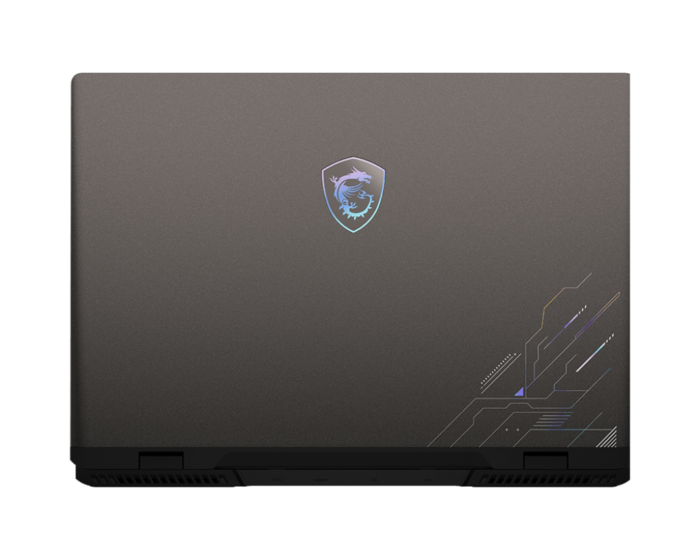
The laptop has the following dimensions: 359×266.4×27.9 mm, and weighs around 2.5kg. The term portability in gaming notebooks is something that manufacturers do not focus on. However, in the case of this laptop, its dimensions are akin to those of a slim-sized briefcase. The thickness and weight of the notebook are acceptable according to gaming laptop standards.
It is also worth mentioning that Crosshair 16 HX supports a 180-degree opening, allowing the user to use the notebook in various scenarios. However, we have observed that this thing is more useful in business-segment notebooks. In gaming notebooks, users mostly use the notebook in the usual way.
MSI Crosshair 16 HX D14V: Display
On opening the notebook, you will find a 16-inch IPS LCD Display with an aspect ratio of 16:10. Thanks to the 16:10 aspect ratio and the thin borders on both left and right, the screen-to-body ratio is higher. The 16-inch LCD Display supports Quad-HD+ resolution (2560×1600) in addition to a 240Hz refresh rate, ensuring that the display’s output is super clear and smooth. The officials also claimed that this display covers 100% DCI-P3 color gamut, making the display more compatible with graphics designers’ needs.

In the display’s top bezel, the webcam is integrated, which supports HD resolution recording (720p@30fps), and the microphone is also here, which supports 3D Noise Reduction. In addition, the manufacturer has also provided a shutter that lets the user block the webcam’s lens to ensure and maintain privacy. However, it is worth noting that this is a common feature in notebooks.
To do the display’s benchmark, we used the Spyder X and found that this display covers 99.7% sRGB, 86.4% AdobeRGB, and 97.5% DCI-P3 color gamut. In terms of color accuracy, the average Delta-E value was 0.15, while the maximum value was 0.93. The benchmark results showed that the MSI Crosshair 16 HX display quality is quite excellent. It is also worth mentioning that the manufacturer has also provided the “MSI True Color” application, a professional display color management software. It allows users to switch between sRGB, AdobeRGB, and Display-P3 color gamuts with one click on the software’s main page. Each color gamut also supports rich options and custom adjustments.
Also Read: Lenovo IdeaPad Pro 5 14AHP9 Review
MSI Crosshair 16 HX D14V: Keyboard
Regarding the keyboard, we have a 24-zone RGB Gaming Keyboard, which supports a personalized lightning effect system, providing a proper gaming environment to users. The keyboard also includes a Numeric Pad, and all the keys have a key travel of 1.7mm. In terms of appearance, it can be seen that the WASD keys are now transparent and illuminated while the size of the arrow keys is also increased.

Under the keyboard, we have a medium-sized TouchPad, providing a very tight feeling when clicking. The palm rest area on the left side of the touchpad features the same futuristic lining design we have on the display shell. The typing and clicking experience on the keyboard and touchpad proved to be highly satisfactory.
MSI Crosshair 16 HX D14V: Ports
Gaming notebooks typically feature a variety of ports, benefiting from the freedom to accommodate thicker bodies compared to business segment notebooks, where slimness is often prioritized. In this notebook, we have ports on three sides: the right, left, and back. Starting from the left side, we have only two ports: a USB 3.2 Gen2 Type-C port (supports DisplayPort and PD 3.0 Charging) and a USB 3.2 Gen1 Type-A port. The Type-C port supports charging at 65W (20V/3.25A) and 100W (20V/5A).
On the backside, we have another USB 3.2 Gen1 Type-A port, an HDMI 2.1 Port (supports 8K@60Hz and 4K@120Hz), an RJ45 LAN Port, and the charging port. We have a single USB 3.2 Gen1 Type-A port on the right, a 3.5mm headphone jack, and a Kensington lock port. The amount of ports in MSI Crosshair 16 HX is reasonable, ensuring that a user wouldn’t be required to have any additional USB dock. Nevertheless, incorporating a USB Thunderbolt 4 port would significantly enhance its versatility and functionality.
MSI Crosshair 16 HX D14V: Battery and Charging
As officials said, the notebook is equipped with a 4-cell 90WHr battery. In addition to this, the company has also provided a 240W AC Adaptor (20V/12A) for charging, which weighs around 500g. Users can also charge the notebook through the only available Type-C port if the charger provided is missing. We also did a battery benchmark test using the PCMark 10 Modern Office application.
Before testing, the power saving mode was turned on, the brightness level was set at 50%, and the battery percentage was 100%. We get a battery backup of 9 hours and 3 minutes. Despite being categorized within the gaming segment, the notebook can deliver satisfactory battery life even when utilized for office tasks.
MSI Crosshair 16 HX D14V: RAM and SSD
Regarding the memory, the notebook we are reviewing comes with a single-channel 16GB DDR5-5600MHz RAM manufactured by SK Hynix. The notebook also supports dual-channel RAM (with two DDR5-5600 slots) and has a maximum RAM capacity of up to 96GB. During the disassembly of the notebook, it can be seen that the RAM slots are in the middle under the heat pipes and covered with black shields. To upgrade RAM capacity, just bought another DDR5-5600MHz RAM module and put it in the second slot.
For testing the RAM, we used the AIDA64 Cache and Memory benchmark application on which we got the following results: 45,457 MB/s Read Speed, 36,381 MB/s Write Speed, and 40,782 MB/s Copy Speed while the latency rate was 82.1ns. The scores are lower, probably because of the single RAM Channel mode.
Next, in the storage section, the notebook comes with a 1TB PCIe 4.0 SSD manufactured by Western Digital. The laptop has two SSD slots, one of which also supports PCIe Gen5 SSDs.
Through the CrystalDiskMark application, we did our SSD’s benchmark test. The benchmark results of SSD were 4,859.82 MB/s Sequential Read Speed, 3385.03 MB/s Sequential Write Speed, 72.31 MB/s 4K Random Read Speed, and 299.18 MB/s 4K Random Write Speed. The SSD’s scores are pretty good.
MSI Crosshair 16 HX D14V: CPU and its Benchmarks
Regarding CPU, the notebook is powered by Intel Core i7-14700HX CPU. It is the only available option in the CPU for this notebook. The CPU is one of the top-tier processors in the gaming segment of laptops. The Intel Core i7-14700HX CPU is based on Intel 7 architecture and consists of 20 cores and 28 threads. These 20 cores include 8 P-Cores (2.1GHz Base Frequency and 5.5GHz Turbo Frequency) and 12 E-Cores (1.5GHz Base Frequency and 3.9GHz Turbo Frequency). The CPU has a 55W TDP and has a 33MB L3 Cache Memory. Following are the benchmark results of CPU:
Cinebench R20: 794pts on Single-Core and 10,268pts on Multi-Core
Cinebench R23: 2,035pts on Single-Core and 26,882pts on Multi-Core
CPU-Z: 879.1 points on Single-Core and 12,244.7 points on Multi-Core
We also compared the benchmark scores of the Intel Core i7-14700HX CPU with the Core i9-13900HX CPU (featured in Dell G16 7630). The CPU was the most powerful CPU in Intel’s 13th-generation processors.
| Core i9-13900HX | Core i7-14700HX | |
| Cinebench R20 Single-Core | 813pts | 794pts |
| Cinebench R20 Multi-Core | 11,135pts | 10,268pts |
| Cinebench R23 Single-Core | 2,099pts | 2,035pts |
| Cinebench R23 Multi-Core | 25,598pts | 26,882pts |
MSI Crosshair 16 HX D14V: GPU and its Benchmark
The manufacturer has provided us with two GPU options: RTX 4060 and RTX 4070. The one we are reviewing is equipped with RTX 4060 mobile GPU. If you have a higher budget and want powerful performance, you can opt for the RTX 4070 GPU option. The RTX 4060 GPU in MSI Crosshair 16 HX has 8GB of GDDR6 Memory and a turbo frequency of 2370MHz with 140W power consumption. Following are the benchmark results of GPU:
3DMark Time Spy: 11,291 Total Score including 11,023 GPU Score
3DMark Time Spy Extreme: 5,468 Total Score including 5,172 GPU Score
MSI Crosshair 16 HX D14V: Gaming Test
We also did a gaming test on MSI Crosshair 16 HX to determine how well this laptop can perform in the gaming segment, which is its primary focus. Following are some games along with their benchmark results:
Counter-Strike 2: One of the most popular online games available on Steam’s platform. On a high resolution of 2.5K, we got an average of 185fps, and peak frame rates were more than 200fps.
Shadow of the Tomb Raider: On the system’s default highest resolution (2560*1600p), we got an average of 85fps. The average frame rate would easily exceed 100fps if we reduce the resolution to 1080p.
Forza Horizon 5: In this test, the highest resolution of 2.5K was set, the image quality was highest, and the ray tracing was also the highest. With these settings, we got an average of 84fps.
Cyberpunk 2077: Initially, we set the resolution to 2.5K while the DLSS was turned off and the ray tracing was turned on. With these settings, we got an average of 40fps. With DLSS turned on and the same settings, the average frame rates were increased to 65fps. When the resolution was reduced to 1080p and the DLSS 3 was enabled, we got 90fps.
MSI Crosshair 16 HX D14V: Heat Dissipation and Stress Testing
The MSI Crosshair 16 HX has an excellent solution for heat dissipation. Four air outlets are on all three sides of the laptop (right, left, and black). On the bottom of the notebook, we have a plastic hollow bottom cover through which you can directly see the exposed copper pipes inside the notebook.

It features six exhausts, allowing for a multi-directional airflow outlet for more efficient cooling. Along with a shared-pipe design with five heat pipes between CPU and GPU, larger thermal pipe diameter, and MSI-exclusive thermal grease, no heat issues are expected in extreme usage of the notebook. To check this, we also did the stress testing on the notebook.
CPU Stress Testing: First, we will test the CPU and GPU separately. For stress testing the CPU, we used the AIDA64 Stress FPU Test. After 10 minutes of testing, the CPU’s power consumption was 120W, and the core temperature stabilized at 85°C.
GPU Stress Testing: This test was done using the FurMark GPU Stress Testing. After 10 minutes of testing, the power consumption reached 140W, and the temperature was around 80°C.
Combined Stress Testing: In this test, the power consumption reached 170W, in which the CPU’s power consumption was around 40W (temperature was 72°C) and the GPU’s power consumption was at 130W (with 76°C temperature). We also checked the temperature using the temperature sensing gun; the highest observed temperature was 41°C at the air outlets (on all three sides), while the temperature on the keyboard surface was around 40°C.
The heat dissipation performance of the MSI Crosshair 16 HX is notably impressive, bordering on exceptional. Its outstanding heat dissipation specifications ensure stable long-term performance, which is particularly advantageous for gamers.
Also Read: ASUS Vivobook S 15 OLED S5506 Review
Summary:
The MSI Crosshair 16 HX notebook boasts impressive features across various aspects. Its design, characterized by a Cosmos Gray color scheme and rugged appearance, coupled with meticulous detailing such as laser-cut designs, offers a visually appealing aesthetic. In terms of dimensions and weight, the notebook balances portability and performance, meeting the standards expected of gaming laptops. Despite its gaming focus, the inclusion of various ports enhances its versatility. Notably, its heat dissipation capabilities are deemed exceptional, promising stable performance over extended periods, a feature highly valued by gamers.
Additionally, the promise of a 9-hour battery backup, even during office work, adds to its appeal as a multifunctional device. Overall, the MSI Crosshair 16 HX emerges as a promising option for users seeking a blend of performance, aesthetics, and functionality in a gaming notebook. The variant we have reviewed is priced at $1200. If you are on a high budget, you can also opt for the version with an RTX 4070 GPU.


